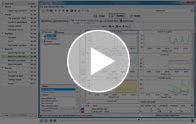About load testing
Why load test web applications?
We load test to...
- test a website vulnerability to crashing under load
- check response times under the predicted load
- determine the number of simultaneous users supported by the application
- define hardware and bandwidth requirements
See the video: NeoLoad in 3 minutes.
Steps
- Record HTTP traffic between browser and server
NeoLoad includes a proxy server that records all server requests and responses.
- Define test parameters
Defining Virtual User behavior and set scenario parameters such as load policy (constant, ramp-up, peak or custom) or the number of Virtual Users to be simulated during the test. Set performance monitors (CPU, memory, disk usage, and so on) for your servers.
- Run the test
Monitor the ongoing test with the aid of real-time graphs and stats.
- Analyze the results
Obtain a summary of the test and then examine its details using the graphs and statistical tables.
NeoLoad records and replays browser requests to the server, which means that NeoLoad:
- can simulate requests made by components such as plug-ins, Java applets, ActiveX, Flash animations, etc.
- cannot simulate local actions such as updating a graphical component using client-side JavaScript.
To get started with your first test, see the Quick Start Guide.
For more information about load testing with NeoLoad 5.5, check our videos on the Neotys website.
Click the image below to see a feature tour of NeoLoad:
